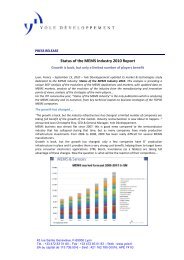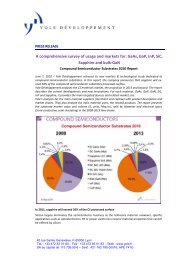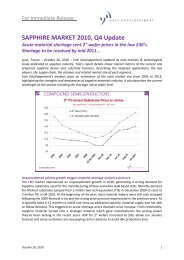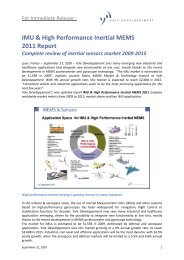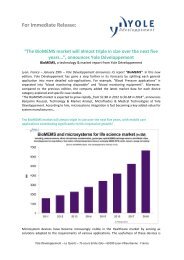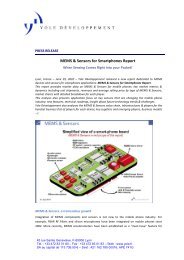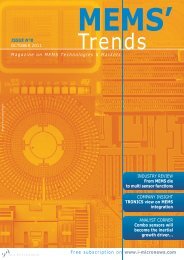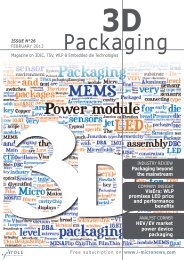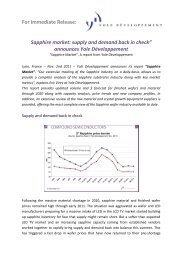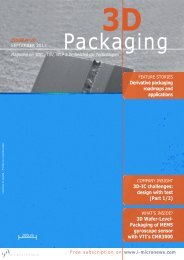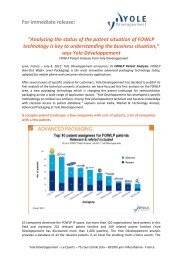Yole Développement top 30 MEMS ranking: STMicroelectronics ...
Yole Développement top 30 MEMS ranking: STMicroelectronics ...
Yole Développement top 30 MEMS ranking: STMicroelectronics ...
You also want an ePaper? Increase the reach of your titles
YUMPU automatically turns print PDFs into web optimized ePapers that Google loves.
APRIL 2012 issue n°128THE DISRUPTIVE SEMICONDUCTOR TECHNOLOGIES MAGAZINELEDPhilips and Optogan sign up to cooperate in LED road lighting solutions in RussiaFrom page 1The Philips-Optogan partnership will focus ondeveloping a local LED industry, supporting theenergy efficiency (EE) initiatives by the Russiangovernment. Switching to LED street and road lightingcan reduce energy consumption by up to 80% andlead to significant savings in service and maintenancecosts. The enhanced visibility created by the brightlight can also contribute to an enhanced feeling ofsecurity and can help improve road safety.Road lighting in Russia is an attractive market segmentas it is anticipated to become one of the leading growthsegments for LED. The Russian road lighting marketis expected to double over the next four years to EUR100 million by 2015.This growth is mainly driven bygovernment energy efficiency programs formodernization of road lighting. It is expected that dueto this also the share of LED will reach 50% as earlyas 2015.www.optogan.comPhoseon Technology delivers high performance UV LED pinning lampFaster, higher quality printing with Angle Reduction Technology.Phoseon Technology has begun shipments ofits newest UV LED product line targeting highspeed,high-quality digital inkjet pinningapplications. The new FireEdge FE200 specificallyaddresses the rapidly growing inkjet market bymatching the length of today’s most popular inkjet printhead dimensions. "Printer manufacturers use thepinning process to ‘freeze’ ink drops before overlayingother colors or doing a full-cure,” stated Mike Willis ofIMI Europe. “It's also used to control gloss or mattesurface finishing characteristics.” “This product is afundamentally new design based on customer inputfrom around the world to enable higher quality at higherspeeds,” said Bill Cortelyou, President and CEO ofPhoseon Technology. “Pinning achieves both goals ina cost-effective way. The FE200 <strong>top</strong> air intake andexhaust eliminate inkjet print head interference andthe units can be scaled to meet a variety of print widthapplications.” Mr. Cortelyou continues, “The optionalpatent-pending Angle Reduction Technologyreduces the angular spread of UV light by up to 67%with no loss of power, minimizing the risk of reflectedlight curing ink in the nozzles. One customer asserted,“The FE200 performed the best of all pinning lampswe’ve tested and the daisy-chain feature for scalingis a great feature. It provided good pinning results with4 colors, even using non-LED inks.” While bringingthe three-tiered benefits of UV LED curing (advancedcapabilities, economic savings, and environmentallyfriendly), Phoseon’s products differentiate themselvesthrough superior performance, integrated control andreal-world reliability for customer’s challenging curingenvironments. Both products will be on display at theupcoming Drupa Trade Fair in Dusseldorf, Germanyat the Phoseon stand 9A46.The new FireEdge FE200 (Courtesy of Phoseon technology)www.phoseon.comVeeco supports growth of LED industry in KoreaVeeco Instruments recently participated in aninvestment signing ceremony at the 2012Korea Investment Forum in New York City tocommemorate the Company’s substantial investmentin a new R&D facility in Seoul, Korea to advance highbrightness light emitting diode (LED) technology.The Investment Forum event, jointly sponsored by theKorea Trade-Investment Promotion Agency (KOTRA)and the Korea Ministry of Knowledge Economy (MKE),brought together government officials, investors,industry experts and business leaders from SouthKorea and the United States to celebrate and promoteinvestment in South Korea by U.S.-based companies.www.veeco.comSensor Electronic Technology reaches milestone UVC LED efficiencies of over10%, bringing consumer disinfection markets within reachSensor Electronic Technology (SETi) announcedrecord efficiencies of ultraviolet light emittingdiodes (UV LEDs) operating in the germicidalUV-C range of 11% external quantum efficiency (EQE)with a corresponding wall-plug efficiency (WPE) of 8%.This industry beating result was achieved under theDARPA Compact Mid-Ultraviolet Technology (CMUVT)program and in collaboration with Army ResearchLaboratories (ARL). This latest development from theworld’s leading supplier of UV LEDs represents morethan a 5X improvement in performance: primarilyattributed to improved light extraction fromencapsulated LED chips with a novel transparentp-region and a reflective contact and further reductionsin defect density in the LED structure, grown onsapphire substrates. Traditionally, UV LEDs have beenmanufactured with GaN p-layers, due to the difficultiesof p-doping AlGaN materials. However, GaN absorbswavelengths shorter than 365nm, and thereforereduces the extraction efficiency of UV LEDs operatingat short wavelengths. SETi have developed acompletely new ptype region using doped AlGaN,which is transparent, even in the UVC range. Thiscoupled with a transparent p-contact significantlyincreases extraction efficiencies. SETi has also furtherdeveloped its MEMOCVD® growth process to reducedislocation densities in the quantum well structure ofUV LEDs grown on sapphire substrates and hasdemonstrated threading dislocation densities (TDD)of less than 2x108 (measured by TEM). Thisimprovement in TDD leads to a high internal quantumefficiency (IQE) of 60%.“This milestone is a very exciting development of UVLEDs, and represents a major step forward in reachingefficiencies of incumbent technologies, such asmedium pressure mercury vapor lamps, which typicallyoperate at efficiencies of 15% or less” said Dr. RemisGaska, President and CEO of SETi. The 350um x350um encapsulated LEDs were designed for emissionat 278nm and measured at Army Research Laboratorywhere they were reported to emit 9.8mW at 20mA (thehighest value ever reported for an LED shorter than365nm at this forward current) and <strong>30</strong>mW at 100mA.Details will be presented at CLEO 2012 meeting, SanJose, CA. SETi has previously reported highly effectiveLED based water treatment systems that disinfectwith >4 log reduction drinking water flowing at 0.5 litersper minute with less than 35mW of optical power at275nm. The results from this development put UV LEDdisinfection systemswithin the reach of consumer markets for applicationssuch as point of use water purification.www.s-et.comCopyrights © <strong>Yole</strong> Développement SA. All rights reserved - Recycled paper13



